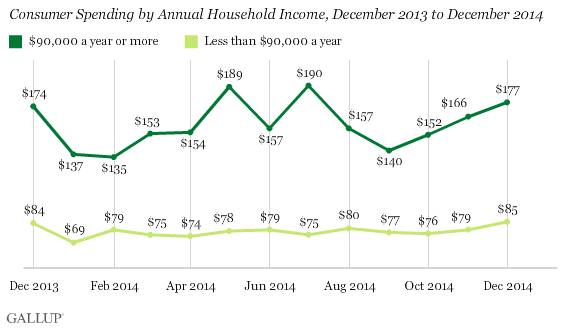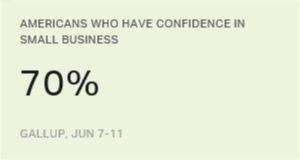Story Highlights
- Spending estimates averaged $98 during December
- December estimates similar to November 2014 and December 2013
- Reported spending still among highest since recession
WASHINGTON, D.C. -- U.S. consumers' average daily spending in December was $98, matching the upper reaches on this measure since 2008. While strong relative to the recent recessionary period, it is similar to the $95 found in November, as well as the $96 in December 2013. This indicates that even though spending is stronger than in the past, some U.S. consumers are still cautious amid positive economic news and growing consumer confidence.

The December 2014 average consumer spending figure is based on Gallup Daily tracking interviews throughout December with more than 13,000 U.S. adults. The poll asks Americans to estimate the total amount they spent "yesterday" in stores, restaurants, gas stations or online -- not counting home and vehicle purchases, or normal monthly bills -- and provides an indication of Americans' discretionary spending.
Because of holiday shopping, December spending has usually been the highest of any month in Gallup's seven-year history of asking this question. That was not the case in 2014, given that December's $98 average matched the $98 from May, and was barely higher than November's average.
The lack of a more significant November-to-December increase, common in prior years, could be a sign that the Christmas retail season was less than robust. However, December spending was up $9 from October, which is more typical of the past pattern, so perhaps holiday shoppers began their shopping earlier.
December Spending Strong Among High- and Low-Income Americans
Upper-income Americans, those whose household incomes are $90,000 or more a year, had daily spending reports averaging $177 in December, among the highest for this group in 2014, and over the years since the recession. The December average is similar to last December's level. Upper-income spending has shown steady gains since September.
Spending among middle- and lower-income Americans, those whose annual household incomes are less than $90,000, was also higher than that found in most other monthly readings Gallup has conducted in the past several years. However, their spending levels in December 2014 roughly matched those in December 2013. Although spending among upper-income Americans often drives the changes in Gallup's monthly estimate, middle- and lower-income Americans make up the bulk of U.S. consumers.

Bottom Line
Consumers' relatively stable spending in December comes at a time when Americans are viewing the country's economic prospects a bit more positively. Low gas prices have loosened their financial constraints a bit, and Americans' views of the job market are sunnier than they have been in years past.
Spending typically drops significantly in January after the holidays are over, but the brighter economic projections in the latter half of 2014 and the improvement in consumer confidence could start 2015 on a higher spending note than in previous Januaries, especially if low gas prices persist into the new year.
Survey Methods
Results for this Gallup poll are based on telephone interviews conducted Dec. 1-30, 2014, on the Gallup U.S. Daily survey, with a random sample of 13,187 adults, aged 18 and older, living in all 50 U.S. states and the District of Columbia. For results based on the total sample of national adults, the margin of sampling error is ±1 percentage points at the 95% confidence level. The margin of error for the spending mean is ±$5. All reported margins of sampling error include computed design effects for weighting.
Each sample of national adults includes a minimum quota of 50% cellphone respondents and 50% landline respondents, with additional minimum quotas by time zone within region. Landline and cellular telephone numbers are selected using random-digit-dial methods.
Learn more about how Gallup Daily tracking works.

